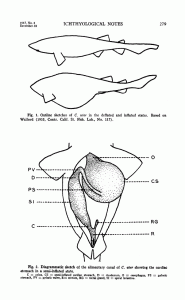The Swell Shark (Cephaloscyllium ventriosum) is a type of shark found in the Eastern Pacific Ocean, specifically from central California down to the Gulf of California, parts of southern Mexico, and along the coast of central Chile. It can grow up to 110cm (43inches) long, and can be found resting over continental shelves and subtropical waters and can be seen as deep as 1,500 metres or as close as 5 metres below the surface.
When threatened, the Swell Shark has a curious defense mechanism. It bends its body into a U-shaped form and grabs its tail fin with its mouth. It then swallows a large amount of water, swelling its body to twice its normal size. This discourages potential predators, making it difficult for the predator to bite or remove the swell shark from a crevice. When the threat passes, the swell shark makes a dog-like bark when expelling the air. If the swell shark is caught and brought to the surface, it can also swell its body with air in the same manner as it does with water.
Click here to watch a Youtube clip of a swelling Swell Shark.
A detailed analysis of how this defense mechanism works:
“The stomach of the shark is divided into two parts – the cardiac stomach, which follows the oesophagus, and the pyloric stomach, which follows the cardiac stomach and leads into the duodenum. The cardiac stomach is the organ that inflates. As in puffer fishes, air or water is gulped into the stomach, inflating the belly region of the fish. The fluid is held in the cardiac stomach of the swell shark by a strong oesophageal sphincter anteriorly and sphincter between the cardiac and pyloric stomachs, posterio-ventrally. The pyloric stomach is flattened out during inflation. It lies, together with the spleen, between the cardiac stomach and the ventral body wall on the right side of the shark. The cardiac stomach swells out in all directions.”
References
“Biological Profiles: Swell Shark”, by Cathleen Bester. Florida Museum of Natural History Ichthyology Department. URL: http://www.flmnh.ufl.edu/fish/Gallery/Descript/SwellShark/SwellShark.html (accessed on: 6 April 2010)
Copeia, Vol. 1947, No. 4, E. Clark, American Society of Ichthyologists and Herpetologists, 1947. “Notes on the Inflating Power of the Swell Shark, Cephaloscyllium uter”, pp. 278-280
Swell Shark (Cephaloscyllium ventriosum), URL: http://www.flickr.com/photos/nostri-imago/3149754860/ (accessed on 6 April 2010)
Swell Shark (Cephaloscyllium ventriosum), URL: http://www.flickr.com/photos/nostri-imago/3148924751/ (accessed on 6 April 2010)



